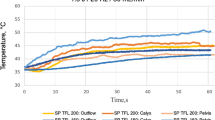Abstract
High-power holmium lasers have become popular for ureteroscopic laser lithotripsy and dusting. Our aim was to investigate the effect of pulse duration and pulse energy on fiber-tip degradation when using high-power settings for popcorn lithotripsy. BegoStones were fragmented in a glass bulb to simulate renal calyx, using a 120 W Ho:YAG laser. A 242 μm fiber was placed via the ureteroscope 2 mm distance from stones (popcorn model). To assess the effect of pulse duration on fiber-tip degradation, long pulse (LP) and short pulse (SP) settings were compared at settings of 1.0Jx20Hz (20 W), 0.5Jx70Hz (35 W), and 1.0Jx40Hz (40 W). To assess the effect of pulse energy on tip degradation, 40 W SP settings (0.5Jx80Hz, 0.8Jx50Hz, and 1.0Jx40Hz) were tested. Pulse duration was measured using a photodetector and peak power was then calculated using the pulse duration and pulse energy. Experiments were conducted for 4 min. Fiber-tip length was measured before and after using a digital caliper. Fiber-tip degradation was least when using LP for all settings tested (p < 0.01). For 40 W settings, tip degradation was significantly lower when using a pulse energy of 0.5 J compared to 0.8 J or 1.0 J (p < 0.004). LP mode results in less fiber burnback for all power settings tested. Total power is more important than frequency in the development of burnback. However, high-power 40 W settings can be utilized with less burnback if lower pulse energies are used. Understanding these parameters can improve the longevity of the laser fiber and improve procedural efficiency.



Similar content being viewed by others

Data availability
N/A
References
Aldoukhi AH, Black KM, Ghani KR (2019) Emerging laser techniques for the management of stones. UrolClin North Am 46(2):193–205. https://doi.org/10.1016/j.ucl.2018.12.005
Aryaei A, Chia R, Peng (2018) The effect of force on laser fiber burnback during lithotripsy. In: Therapeutics and diagnostics in urology 2018. vol 10468. International society for optics and photonics:104680I. https://doi.org/10.1117/12.2286285
Dauw CA, Simeon L, Alruwaily AF et al (2015) Contemporary practice patterns of flexible ureteroscopy for treating renal stones: results of a worldwide survey. J Endourol 29(11):1221–1230. https://doi.org/10.1089/end.2015.0260
Sroka R, Pongratz T, Scheib G et al (2015) Impact of pulse duration on Ho:YAG laser lithotripsy: treatment aspects on the single-pulse level. World J Urol 33(4):479–485. https://doi.org/10.1007/s00345-015-1504-9
Wollin DA, Ackerman A, Yang C et al (2017) Variable pulse duration from a new holmium:yag laser: the effect on stone comminution, fiber-tip degradation, and retropulsion in a dusting model. Urology 103:47–51. https://doi.org/10.1016/j.urology.2017.01.007
Shin RH, Lautz JM, Cabrera FJ et al (2015) Evaluation of novel ball-tip holmium laser fiber: impact on ureteroscope performance and fragmentation efficiency. J Endourol 30(2):189–194. https://doi.org/10.1089/end.2015.0300
Aldoukhi AH, Roberts WW, Hall TL, Teichman JMH, Ghani KR (2018) Understanding the popcorn effect during holmium laser lithotripsy for dusting. Urology 122:52–57. https://doi.org/10.1016/j.urology.2018.08.031
Average and peak power – a tutorial - newport corporation. https://www.newport.com/medias/sys_master/images/images/h8f/h7a/8797052108830/Average-and-Peak-Power-Calculation-Tech-Note-1.pdf. Accessed February 22, 2020
Pulsed lasers introduction to power and energy calculations (n.d.) Retrieved October 05, 2020, from https://www.thorlabs.com/images/tabimages/Laser_Pulses_Power_Energy_Equations.pdf
Nazif OA, Teichman JMH, Glickman RD, Welch AJ (2004) Review of laser fibers: a practical guide for urologists. J Endourol 18(9):818–829. https://doi.org/10.1089/end.2004.18.818
Paschotta D (2020) Peak power. retrieved September 27, 2020, from https://www.rp-photonics.com/peak_power.html
Mues AC, Teichman JMH, Knudsen BE (2009) Quantification of holmium: yttrium aluminum garnet optical tip degradation. J Endourol 23(9):1425–1428. https://doi.org/10.1089/end.2009.0384
Castelbuono J, Teichman J, Knudsen B (2012) 2123 Holmium :YAG optical fiber burnback varies with stone composition. J Urol 187(4S). https://doi.org/10.1016/j.juro.2012.02.2292
Marks AJ, et al (2008) Holmium:yttrium-aluminum-garnet lithotripsy proximal fiber failures from laser and fiber mismatch. J Urol. 71 (6): 1049-1051. https://doi.org/10.1016/j.urology.2007.10.060
Acknowledgments
This study was supported by a scientific research grant from Boston Scientific.
Funding
This study was supported by a scientific research grant from Boston Scientific.
Author information
Authors and Affiliations
Contributions
All authors read and approved the final manuscript. Ali H. Aldoukhi and Khurshid R. Ghani designed the study. Brandon A. Levin, Ali H. Aldoukhi, and Khurshid R. Ghani drafted the manuscript. Kristian M. Black analyzed the data. William W. Roberts, Tim L. Hall, and Khurshid R. Ghani critically revised the manuscript. All authors commented on and approved the final manuscript.
Corresponding author
Ethics declarations
Conflicts of interest
Khurshid R. Ghani is a consultant for Lumenis, Boston Scientific, Olympus and Coloplast. William W. Roberts is a consultant for Boston Scientific
Research involving human participants and/or animals
N/A
Informed consent
N/A
Code availability
N/A
Additional information
Publisher’s note
Springer Nature remains neutral with regard to jurisdictional claims in published maps and institutional affiliations.
Supplementary information
ESM 1
(PDF 5921 kb)
Rights and permissions
About this article
Cite this article
Levin, B.A., Aldoukhi, A.H., Black, K.M. et al. Burnback: the role of pulse duration and energy on fiber-tip degradation during high-power laser lithotripsy. Lasers Med Sci 36, 1817–1822 (2021). https://doi.org/10.1007/s10103-020-03199-5
Received:
Accepted:
Published:
Issue Date:
DOI: https://doi.org/10.1007/s10103-020-03199-5



